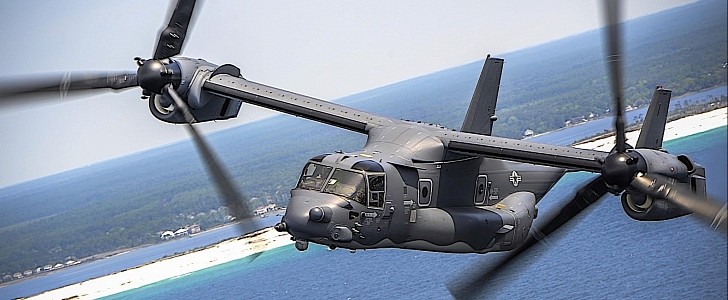Since the end of March and until the end of last week, the U.S. military and the Armed Forces of the Philippines ran something called Balikatan 2022. The military exercise, the 37th of its kind, involved about 5,100 Americans and, as you might have thought, they brought their gear with them.
For the Marine Medium Tiltrotor Squadron 363 (VMM-363), based at Marine Corps Base Hawaii, that gear would be the mighty MV-22 Osprey tiltrotors. The squadron, nicknamed Lucky Red Lions, is tasked with supporting troops on the ground and routinely takes part in training exercises.
As they were preparing for Balikatan, the Red Lions managed to achieve “one of the longest maritime VMM self-deployment flights in 1st Marine Aircraft Wing history.” More to the point, an undisclosed number of Ospreys flew for a total of over 4,730 nautical miles (5,443 miles/8,760 km).
That’s a lot more than double the factory-rated 2,230 nautical miles (2,566 miles/4,129 km) range for self-deploy with a single aerial refueling. And a hell of a lot more than the 430 nautical miles (495 miles/795 km) this Marine Corps-spec tiltrotor is capable of with 24 troops and their gear on board.
“This movement has significant strategic value in demonstrating VMM-363’s ability to self-deploy across the INDOPACOM AOR and reaffirms the capability and operational reach that the MV-22 Osprey brings to the nation’s naval expeditionary force-in-readiness,” said in a statement last week Lt. Col. Joe Whitefield, Commanding Officer of VMM-363.
The Osprey is an aircraft developed by Bell and Boeing. It was introduced at the end of the 1980s as a niche “joint service multirole combat aircraft” and is configured in such a way that it can take off and land like a helicopter, but fly like an airplane.
It is powered by two Rolls-Royce engines developing 6,150 shaft horsepower each, sitting in dedicated nacelles.
As they were preparing for Balikatan, the Red Lions managed to achieve “one of the longest maritime VMM self-deployment flights in 1st Marine Aircraft Wing history.” More to the point, an undisclosed number of Ospreys flew for a total of over 4,730 nautical miles (5,443 miles/8,760 km).
That’s a lot more than double the factory-rated 2,230 nautical miles (2,566 miles/4,129 km) range for self-deploy with a single aerial refueling. And a hell of a lot more than the 430 nautical miles (495 miles/795 km) this Marine Corps-spec tiltrotor is capable of with 24 troops and their gear on board.
“This movement has significant strategic value in demonstrating VMM-363’s ability to self-deploy across the INDOPACOM AOR and reaffirms the capability and operational reach that the MV-22 Osprey brings to the nation’s naval expeditionary force-in-readiness,” said in a statement last week Lt. Col. Joe Whitefield, Commanding Officer of VMM-363.
The Osprey is an aircraft developed by Bell and Boeing. It was introduced at the end of the 1980s as a niche “joint service multirole combat aircraft” and is configured in such a way that it can take off and land like a helicopter, but fly like an airplane.
It is powered by two Rolls-Royce engines developing 6,150 shaft horsepower each, sitting in dedicated nacelles.










